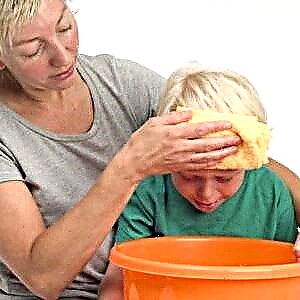Vomiting is a common occurrence in many children, especially with rotavirus.
In most cases, episodes of vomiting should go away within 24 hours, but if the vomiting continues longer or the child vomits blood, see your pediatrician.
Vomiting blood is not always a symptom of a serious medical problem, but a specialist assessment is required.
The medical term for bloody vomiting is hematemesis. This symptom usually occurs due to diseases in the upper gastrointestinal tract (gastrointestinal tract), that is, due to problems in the esophagus, stomach, or due to disease in the first section of the small intestine.
Bloody vomiting is a medical emergency. Bleeding often stops fairly quickly, but sometimes it is severe and life threatening. Therefore, call an ambulance or go directly to the nearest hospital if your child has bloody vomiting.
Blood is usually present in vomit that is either bright red or dark brown coffee grounds.
Vomiting with bright red blood means that bleeding started just before vomiting, while vomiting of dark blood (often the color of coffee grounds) indicates that blood has been in the stomach for some time and iron in the blood has been oxidized by stomach acids.
Common causes
There are many reasons for the presence of blood in vomit:
1. Cracked nipples in a nursing mother.
In most breastfed babies, blood in the vomit is due to blood leaking from the cracked mother's nipples, and not due to bleeding in the baby's body.
Usually, breastfeeding mothers who have just started breastfeeding experience irritation and pain in the nipples due to stretching and pressure, or due to saliva on the skin. This leads to cracks, and the blood flows to the child.
In most cases, a healthy breastfed baby who is vomiting blood has simply swallowed some blood from the mother's sore nipple. The blood irritates the stomach and regurgitation occurs.
If you don't see cracks in your nipples, try pumping some milk and check to see if it's stained with blood.
If you see blood in breast milk or on the nipple, offer plain water to the baby after feeding to allow the blood to flow out of the stomach on its own. Do not feed through a damaged nipple for several days until it heals. You can use a nipple pad available at pharmacies to avoid irritating your healthy nipple.
The blood that passes through the breast milk will also mix with the intestines and you will see blood in the baby's stool.
2. Swallowing blood during birth.
If a baby vomits blood shortly after birth, it may be the mother's blood that the baby swallowed during labor. However, you should contact a specialist to observe the crumbs.
 3. Nosebleeds.
3. Nosebleeds.
Often, blood from the nasal cavity enters the mouth and is swallowed. This irritates the stomach and vomits blood.
4. Tuberculosis.
Lung infection is a serious cause of blood vomiting in children.
5. Condition of blood counts.
Rarely, a decrease in the number of platelets in the blood (thrombocytopenia), leukemia, hemophilia, or anemia can cause bloody vomiting.
Esophageal bleeding
There may be several reasons for this phenomenon:
- Dilation of the esophageal veins. Enlarged blood vessels in the lining of the esophagus or stomach are a possible complication of liver cirrhosis. In cirrhosis, damaged liver tissue obstructs blood flow through the organ. This increases the pressure in the vein, which draws blood to the liver from the intestines. The increased pressure provokes stagnation of blood in the vessels, makes the veins "swell" in the walls of the esophagus. The dilated vessels are very fragile and can bleed profusely.
- Inflammation of the esophagus. Often due to acid reflux. Sometimes the inflamed esophagus bleeds.
- Mallory-Weiss syndrome. This is bleeding caused by an injury (crack) to the lining of the esophagus or stomach. An injury can be caused by a sudden spike in pressure in these organs due to repeated vomiting, excessive exertion, severe coughing, or hiccupping.
Gastric bleeding
The reasons for this condition should be considered in more detail:
1. Stomach ulcer. An ulcer is a defect in the form of a small hole in the stomach lining. The ulcer may bleed, sometimes severely.

There are several causes of stomach ulcers:
- bacterial infection Helicobacter pylori;
- taking anti-inflammatory drugs sometimes causes stomach ulcers;
- Aspirin, usually used to prevent blood clots
- stress.
2. Stomach cancer sometimes causes gastric bleeding.
3. Inflammation of the stomach lining (gastritis) has similar causes with a stomach ulcer.
4. Expansion of veins in the lining of the stomach. May occur similarly to esophageal varicose veins described above.
5. Mallory-Weiss syndrome.
Bleeding from the upper small intestine
The reasons for this condition also deserve a detailed discussion:
 Duodenal ulcer. Like a stomach ulcer, it is usually caused by an H. pylori infection. Anti-inflammatory medicines and Aspirin, both common causes of stomach ulcers, rarely cause ulcers in the intestines.
Duodenal ulcer. Like a stomach ulcer, it is usually caused by an H. pylori infection. Anti-inflammatory medicines and Aspirin, both common causes of stomach ulcers, rarely cause ulcers in the intestines.- Inflammation of the duodenum has similar causes as with duodenal ulcers.
What should parents do?
Vomiting blood is not necessarily a sign of a serious illness. Blood in the vomit is common when the force of the gag reflex causes tiny tears in the blood vessels that line the esophagus. Sometimes there may be streaks of blood in the child's vomit if he has nosebleeds and has swallowed blood.
If your child is constantly vomiting or has more blood, call the pediatrician. Take your children to the nearest hospital immediately if they vomit with a lot of blood loss.
Sores in the throat from violent vomiting can become large and cause significant bleeding. The child may also develop obstruction in the upper part of the small intestine.
Vomiting can be accompanied by other symptoms - the child is nauseous, he has diarrhea, fever, general weakness and irritability. Other symptoms to watch out for include deep, rapid breathing, decreased urinary frequency, abdominal pain, and pale skin. Sometimes a child's vomiting is a symptom of a more serious illness.
Take your child to the hospital if their vomit contains green bile or blood that looks like dark coffee grounds. The baby may have bleeding in the upper gastrointestinal tract, this requires immediate medical attention.
Even in the absence of a more serious medical condition, vomiting that lasts more than 24 hours can lead to dehydration, especially when the child has diarrhea. It doesn't matter what the cause of vomiting is, your baby loses a lot of fluid when vomiting.
Dehydration is a common side effect of persistent vomiting, especially if the child is not drinking enough fluids to replace the fluid that his body is losing. If left untreated, dehydration can cause serious complications or become life-threatening.
Diagnostics
Doctor's assessment
The doctor will ask various questions about the nature of vomiting and will ask if there are other complaints and symptoms, and will conduct an examination.
 The doctor will try to find out if this blood really comes from the upper GI tract.
The doctor will try to find out if this blood really comes from the upper GI tract.
The doctor should understand how much blood the child has lost and how serious it is by questioning, checking the pulse and blood pressure.
If it is clear that blood is coming from the upper parts of the gastrointestinal tract, tests are usually done to determine the cause.
Blood test
Blood tests are usually done to assess the overall situation. For example, how much blood has been lost, whether fluid needs to be given intravenously, or whether a blood transfusion is necessary because of a large blood loss.
In addition, a blood test can help assess liver function, for example if there is “scarring” (cirrhosis), or is helpful in diagnosing and assessing other causes of bleeding.
Gastroscopy
Gastroscopy (endoscopy) is a method of internal examination. A thin flexible telescope is passed up the esophagus into the stomach and into the duodenum. The cause of the bleeding can often be determined using endoscopy.
Treatment
Initial treatment may require an IV drip to inject special fluids into a vein to replace the loss, or a blood transfusion if the bleeding is severe. This is not necessary if the bleeding was mild and stopped.
Try to get your baby to sleep more as this helps empty the stomach. Stomach contents usually drain into the intestines during sleep, preventing the baby's need to vomit.
However, when the bleeding is severe, resuscitation and urgent fluid / blood replacement are needed.
Initial treatment to stop any bleeding is often done with instruments that are passed through an endoscope. Sometimes emergency surgery is needed to control severe bleeding. After the bleeding stops, further treatment is carried out depending on the cause.
For any ailments in a child, a specialist consultation is required, and vomiting of blood is always a problem, regardless of the cause. Whether the nosebleeds have entered the stomach or the abdominal trauma has caused internal bleeding, the cause of the vomiting needs to be investigated further to stabilize the child's condition.

 Duodenal ulcer. Like a stomach ulcer, it is usually caused by an H. pylori infection. Anti-inflammatory medicines and Aspirin, both common causes of stomach ulcers, rarely cause ulcers in the intestines.
Duodenal ulcer. Like a stomach ulcer, it is usually caused by an H. pylori infection. Anti-inflammatory medicines and Aspirin, both common causes of stomach ulcers, rarely cause ulcers in the intestines.

